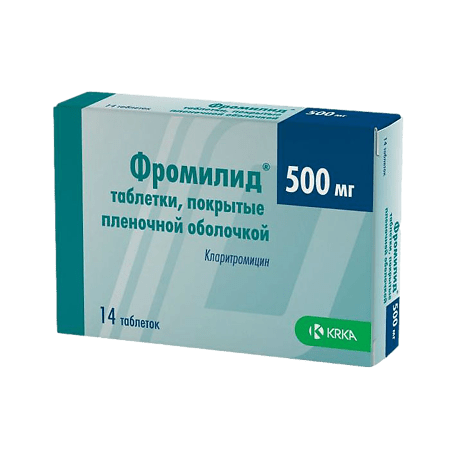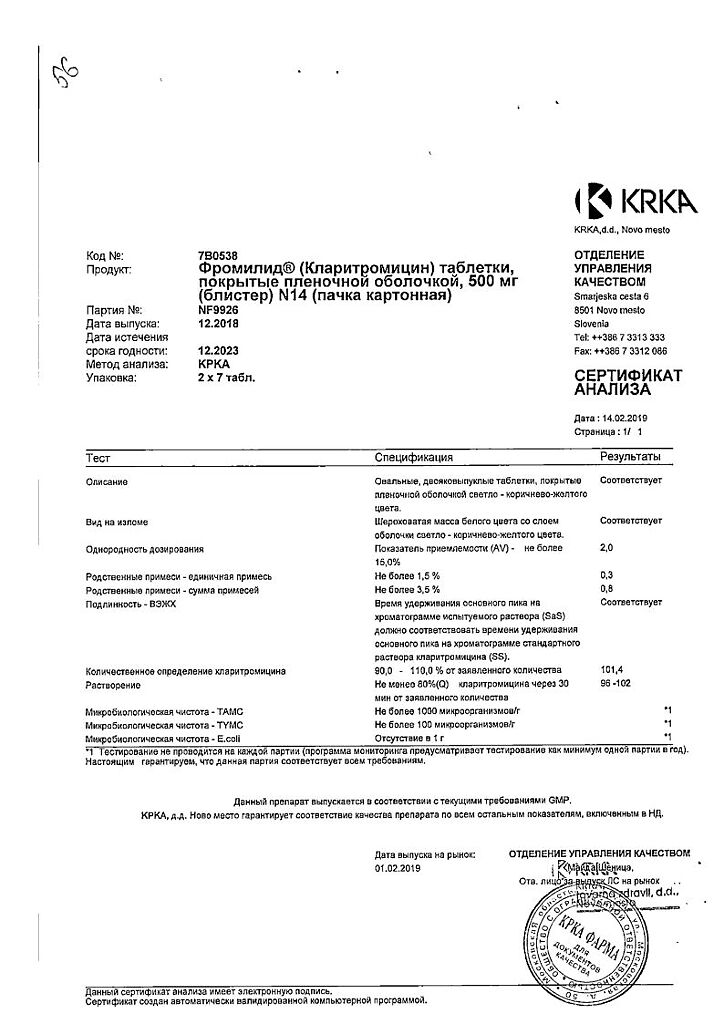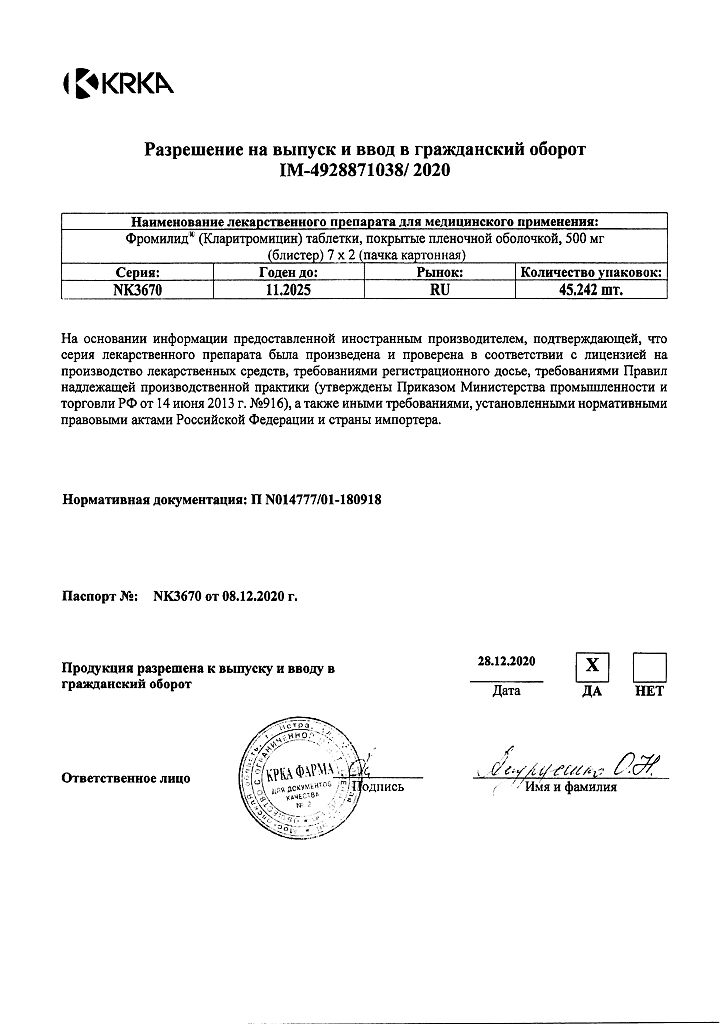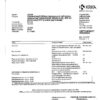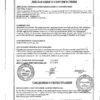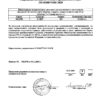No products in the cart.
Fromilide, 500 mg 14 pcs
€14.47 €12.05
Description
Pharmacological action Pharmacological action – antibacterial.
Pharmacodynamics
Clarithromycin is a semi-synthetic antibiotic of macrolide group and has antibacterial action by interacting with 50S ribosomal subunit and inhibiting protein synthesis of bacteria sensitive to it.
Clarithromycin has shown high in vitro activity against both standard laboratory strains of bacteria and those isolated from patients in clinical practice. It shows high activity against many aerobic and anaerobic gram-positive and gram-negative microorganisms. IPC of clarithromycin for most pathogens is lower than IPC of erythromycin, on average by one log2 dilution.
Clarithromycin is highly active against Legionella pneumophila, Mycoplasma pneumoniae under in vitro conditions. It has a bactericidal effect against Helicobacter pylori; this activity of clarithromycin is higher at neutral pH than at acidic pH.
In addition, in vitro and in vivo data indicate that clarithromycin acts against clinically relevant mycobacterial species. Enterobacteriaceae and Pseudomonas spp. as well as other non-lactose-fermenting Gram-negative bacteria are not sensitive to clarithromycin.
The activity of clarithromycin against most strains of the microorganisms listed below has been demonstrated both in vitro and in clinical practice for the diseases listed under “Indications”.
Aerobic gram-positive microorganisms: Staphylococcus aureus, Streptococcus pneumoniae, Streptococcus pyogenes, Listeria monocytogenes.
Aerobic gram-negative microorganisms: Haemophilus influenzae, Haemophilus parainfluenzae, Moraxella catarrhalis, Neisseria gonorrhoeae, Legionella pneumophila.
Other microorganisms: Mycoplasma pneumoniae, Chlamydia pneumoniae (TWAR).
Mycobacteria: Mycobacterium leprae, Mycobacterium kansasii, Mycobacterium chelonae, Mycobacterium fortuitum, Mycobacterium avium complex (MAC) (complex including: Mycobacterium avium, Mycobacterium intracellulare).
The production of beta-lactamase has no effect on clarithromycin activity. Most staphylococcal strains resistant to methicillin and oxacillin are also resistant to clarithromycin.
Helicobacter pylori. Sensitivity of Helicobacter pylori to clarithromycin was studied in Helicobacter pylori isolates isolated from 104 patients before the start of therapy with the drug. Clarithromycin-resistant Helicobacter pylori strains were isolated in 4 patients, 2 patients had moderate resistance strains, and the remaining 98 patients’ Helicobacter pylori isolates were sensitive to clarithromycin.
Clarithromycin has action in vitro and against most strains of the following microorganisms (however, the safety and efficacy of clarithromycin in clinical practice has not been confirmed by clinical studies, and the practical value remains unclear):
Aerobic gram-positive microorganisms: Streptococcus agalactiae, Streptococci (groups C, F, G), Viridans group streptococci.
Aerobic gram-negative microorganisms: Bordetella pertussis, Pasteurella multocida.
Anaerobic gram-positive microorganisms: Clostridium perfringens, Peptococcus niger, Propionibacterium acnes.
Anaerobic gram-negative microorganisms: Bacteroides melaninogenicus.
Spirochetes: Borrelia burgdorferi, Treponema pallidum.
Campylobacter: Campilobacter jejuni.
The main metabolite of clarithromycin in humans is the microbiologically active metabolite 14-hydroxyclarithromycin (14-OH-clarithromycin).
The microbiological activity of the metabolite is the same as that of the parent substance, or 2 times weaker against most microorganisms. The exception is Haemophilus influenzae, against which the effectiveness of the metabolite is 2 times higher. The parent compound and its main metabolite have additive; synergistic effect against Haemophilus influenzae under in vitro and in vivo conditions depending on the bacterial strain.
Pharmacokinetics
Intake. The drug is rapidly absorbed in the gastrointestinal tract. Absolute bioavailability is about 50%. No cumulation was found when multiple doses of the drug were administered, and the character of metabolism in human body did not change. Eating immediately before taking the drug increased the bioavailability of the drug, on average by 25%. Clarithromycin can be used before meals or with meals.
Distribution, metabolism and excretion
In vitro. Clarithromycin binds to plasma proteins by 70% at concentrations from 0.45 to 4.5 µg/ml. At a concentration of 45 µg/ml, the binding decreases to 41%, probably as a result of saturation of the binding sites. This is observed only at concentrations many times greater than the therapeutic concentration.
In vivo. In vivo animal studies have shown that clarithromycin is present in all tissues, except in the CNS, at concentrations several times greater than plasma concentrations. The highest concentrations (10-20 times higher than plasma concentrations) were found in the liver and lungs.
Healthy. When clarithromycin was administered at a dose of 250 mg 2 times daily, the Css of clarithromycin and 14-OH-clarithromycin in plasma was reached after 3 days and was 1 and 0.6 µg/ml, respectively. T1/2 of clarithromycin and its main metabolite were 3-4 and 5-6 h, respectively. When clarithromycin was administered at a dose of 500 mg twice daily, Cmax of clarithromycin and 14-OH-clarithromycin in plasma was reached after the 5th dose and averaged 2.7-2.9 and 0.88-0.83 mcg/ml, respectively. The T1/2 of clarithromycin and its main metabolite were 4.5-4.8 and 6.9-8.7 h, respectively.
The Cmax of 14-OH-clarithromycin in plasma did not increase in proportion to the oral dose of clarithromycin, whereas the T1/2 of both clarithromycin and 14-OH-clarithromycin tended to lengthen with increasing dose. This nonlinear pharmacokinetics of clarithromycin, combined with decreased formation of 14-hydroxylated and N-demethylated products at high doses, indicates a nonlinear metabolism of clarithromycin that becomes more pronounced at higher doses.
The urinary excretion is about 37.9% after oral clarithromycin doses of 250 mg and 46% after clarithromycin doses of 1200 mg; about 40.2% and 29.1%, respectively, are excreted through the intestine.
Patients. Clarithromycin and 14-OH-clarithromycin penetrate rapidly into tissues and body fluids.
There is limited evidence that the concentration of clarithromycin in cerebrospinal fluid when ingested is negligible (i.e., only 1-2% of the serum concentration with normal HEB permeability). Concentrations in tissues are usually several times higher than in blood serum.
The table shows examples of tissue and serum concentrations.
| Concentrations (250 mg every 12 h) | |||
| Tissue type | Tissue, µg/g | Serum, µg/mL | |
| tonsils | 1.6 | 0.8 | |
| Lungs | Lungs | 8.8 | 1.7 |
Liver function impairment. No clarithromycin dose adjustment is required in patients with moderate to severe hepatic impairment but with preserved renal function. Plasma Css and systemic clearance of clarithromycin do not differ between patients in this group and healthy patients. Css of 14-OH clarithromycin is lower in patients with liver dysfunction than in healthy patients.
Renal dysfunction. Impaired renal function increases plasma Cmax and Cmin of clarithromycin, T1/2, AUC of clarithromycin and its metabolite (14-OH clarithromycin). The elimination constant and renal excretion decreases. The degree of change in these parameters depends on the degree of renal impairment.
In elderly patients. In elderly patients, plasma concentrations of clarithromycin and its metabolite 14-OH-clarithromycin were higher and excretion slower than in the younger group. However, after adjustment for renal creatinine clearance, there were no differences in the two groups. Thus, the main influence on the pharmacokinetic parameters of clarithromycin is renal function, not age.
Patients with mycobacterial infections. The Css of clarithromycin and 14-OH clarithromycin in patients with HIV infection who received clarithromycin at conventional doses (500 mg twice daily) were similar to those in healthy subjects. However, when clarithromycin is used in higher doses that may be necessary to treat mycobacterial infections, concentrations of the antibiotic may be significantly higher than usual.
In HIV-infected patients taking clarithromycin at a dose of 1000 or 2000 mg/day in 2 doses, Css were typically 2-4 and 5-10 mcg/ml, respectively. T1/2 prolongation was observed with clarithromycin at higher doses compared with that of healthy volunteers receiving clarithromycin at normal doses. Increased plasma concentrations and prolongation of T1/2 when using clarithromycin at higher doses are due to non-linear pharmacokinetics of the drug.
Combination treatment with omeprazole. Clarithromycin 500 mg 3 times daily in combination with omeprazole at a dose of 40 mg/day promotes prolongation of T1/2 and increase of AUC0-24 of omeprazole. There was an 89% increase in AUC0-24 and 34% increase in T1/2 of omeprazole in all patients who received combination therapy compared to patients who received omeprazole alone.
In clarithromycin, Cmax, Cmin and AUC0-8 were increased by 10, 27 and 15%, respectively, compared with those of clarithromycin without omeprazole. Css of clarithromycin in the gastric mucosa 6 h after clarithromycin administration in the group receiving the combination were 25 times higher than in patients receiving clarithromycin alone. Gastric tissue concentrations of clarithromycin 6 hours after clarithromycin and omeprazole were twice as high as in the clarithromycin alone group.
Indications
Indications
– Lower respiratory tract infections (such as bronchitis, pneumonia);
– Upper respiratory tract infections (such as pharyngitis, sinusitis);
– Skin and soft tissue infections (such as folliculitis, subcutaneous tissue inflammation, rust);
– disseminated or localized mycobacterial infections caused by Mycobacterium avium and Mycobacterium intracellulare;
– localized infections caused by Mycobacterium chelonae, Mycobacterium fortuitum and Mycobacterium kansasii;
– prevention of the spread of infection caused by Mycobacterium avium complex (MAC), HIV-infected patients with a CD4 (T-helper lymphocytes) count of 100 or less in 1 mm3;
p> – eradication of Helicobacter pylori and reduction of duodenal ulcer recurrence rate;
– odontogenic infections (only for the drug Fromilide®, film-coated tablets, 250 mg).
Active ingredient
Active ingredient
Composition
Composition
1 film-coated tablet contains:
the active substance:
clarithromycin – 500 mg,
excipients: corn starch, 500 mg; MCC (type 101), 54 mg; MCC (type 102), 55 mg; colloidal anhydrous silica, 13 mg; pregelatinized starch, 100 mg; potassium polacryline, 30 mg; talc, 33 mg; magnesium stearate, 15 mg.
Film coating: hypromellose 6 cps – 28.87 mg; talc – 2.33 mg; iron oxide yellow dye (E172) – 0.4 mg; propylene glycol – 2.2 mg; titanium dioxide (E171) – 6.2 mg.
How to take, the dosage
How to take, the dosage
Orally, regardless of the time of meals.
The usual recommended dose of clarithromycin in adults and children over 12 years of age is 250 mg 2 times daily (in this case, Fromilide®, film-coated tablets 250 mg may be used).
Clarithromycin 500 mg 2 times a day is used for more severe infections. The usual duration of treatment is 5 to 14 days.
The exceptions are community-acquired pneumonia and sinusitis, which require 6 to 14 days of treatment.
Doses for the treatment of mycobacterial infections other than tuberculosis. For mycobacterial infections, a clarithromycin dose of 500 mg twice daily is recommended. Treatment of disseminated MAC infections in patients with AIDS should be continued as long as there is clinical and microbiological efficacy.
Clarithromycin should be administered in combination with other antimicrobials active against these pathogens. The duration of treatment of other non-tuberculous mycobacterial infections is determined by the physician.
For the prevention of infections caused by MAC. The recommended dose of clarithromycin for adults is 500 mg twice a day.
In odontogenic infections, the dose of clarithromycin is 250 mg (1 tablet of Fromilid®, film-coated tablets, 250 mg) 2 times daily for 5 days.
For eradication of Helicobacter pylori. In patients with peptic ulcer disease caused by Helicobacter pylori infection clarithromycin may be used 500 mg 2 times daily in combination with other antimicrobial agents and proton pump inhibitors for 7-14 days, in accordance with national and international recommendations for treatment of Helicobacter pylori infection.
Patients with renal insufficiency. Patients with creatinine Cl less than 30 ml/min are prescribed half of usual clarithromycin dose (in this case – 250 mg). These patients are not treated for more than 14 days.
Interaction
Interaction
The use of the following drugs concomitantly with clarithromycin is contraindicated due to the possibility of serious side effects.
Cisapride, pimozide, terfenadine and astemizole. Concomitant administration of clarithromycin with cisapride, pimozide, terfenadine or astemizole has been reported to increase plasma concentrations of the latter, which may lead to prolongation of the QT interval on ECG and to cardiac arrhythmias, including ventricular tachycardia (including pirouette-type ventricular tachycardia) and ventricular fibrillation (see Contraindications).
A ergot alkaloids. Post-marketing studies indicate that concomitant use of clarithromycin with ergotamine or dihydroergotamine may cause the following effects associated with acute poisoning with ergotamines: vasospasm, ischemia of the extremities and other tissues, including the CNS. Concomitant use of clarithromycin and ergot alkaloids is contraindicated (see “Contraindications”).
HMG-CoA reductase inhibitors (statins). Concomitant use of clarithromycin with lovastatin or simvastatin is contraindicated (see “Contraindications”) due to the fact that these statins are largely metabolized by CYP3A4 isoenzyme and simultaneous use with clarithromycin increases their serum concentrations, which leads to increased risk of myopathy, including rhabdomyolysis.
Cases of rhabdomyolysis have been reported in patients taking clarithromycin concomitantly with these drugs. If clarithromycin should be used, lovastatin or simvastatin should be discontinued for the duration of therapy. Clarithromycin should be used with caution in case of combined therapy with other statins. It is recommended to use statins whose metabolism does not depend on CYP3A isoenzyme (e.g., fluvastatin). If concomitant administration is necessary, it is recommended to take the lowest dose of statin. The development of signs and symptoms of myopathy should be monitored.
The effect of other drugs on clarithromycin
Drugs that are inducers of the CYP3A isoenzyme (e.g. rifampicin, phenytoin, carbamazepine, phenobarbital, St. John’s wort) may induce the metabolism of clarithromycin. This may lead to subtherapeutic concentrations of clarithromycin and thus a decrease in efficacy. In addition, it is necessary to monitor the plasma concentration of CYP3A isoenzyme inducer, which may increase due to inhibition of CYP3A isoenzyme by clarithromycin. Concomitant use of rifabutin and clarithromycin resulted in increased concentrations of rifabutin and decreased plasma concentrations of clarithromycin with increased risk of uveitis.
The following drugs have proven or suspected effects on plasma concentrations of clarithromycin, dosage adjustment or switch to alternative treatment may be required if they are used concomitantly with clarithromycin.
Efavirenz, nevirapine, rifampicin, rifabutin and rifapentine. Strong cytochrome P450 inducers such as efavirenz, nevirapine, rifampicin, rifabutin and rifapentine can accelerate the metabolism of clarithromycin and thus decrease the plasma concentration of clarithromycin and weaken the therapeutic effect, and at the same time increase the plasma concentration of 14-OH clarithromycin, a metabolite that is also microbiologically active. Since microbiological activity of clarithromycin and 14-OH clarithromycin differs with respect to different bacteria, the therapeutic effect may be reduced when clarithromycin and cytochrome P450 system inducers are used concomitantly.
Etravirin. Plasma concentrations of clarithromycin are decreased when concomitant use with etravirine, but plasma concentrations of the active metabolite 14-OH-clarithromycin are increased. Since 14-OH-clarytromycin has low activity against MAC infections, the overall activity against these pathogens may be altered, so alternative treatment should be considered for MAC treatment.
Fluconazole. Concomitant administration of fluconazole at a dose of 200 mg daily and clarithromycin at a dose of 500 mg twice daily in 21 healthy volunteers resulted in a 33-18% increase in the mean equilibrium Cmin and AUC of clarithromycin, respectively. At the same time, concomitant administration had no significant effect on the mean Css of the active metabolite 14-OH clarithromycin. Dose adjustment of clarithromycin in case of concomitant administration of fluconazole is not required.
Ritonavir. A pharmacokinetic study has shown that concomitant administration of ritonavir at a dose of 200 mg every 8 hours and clarithromycin at a dose of 500 mg every 12 hours resulted in a marked inhibition of clarithromycin metabolism. Concomitant administration of ritonavir increased the Cmax of clarithromycin by 31%, the Cmin increased by 182%, and the AUC increased by 77%. Complete inhibition of 14-OH clarithromycin was noted.
The wide therapeutic range of clarithromycin does not require dose reduction in patients with normal renal function. In patients with renal impairment it is reasonable to consider the following dose adjustments: in creatinine Cl 30-60 ml/min the dose of clarithromycin should be reduced by 50%, in creatinine Cl less than 30 ml/min the dose of clarithromycin should be reduced by 75%. Ritonavir should not be taken concomitantly with clarithromycin in doses greater than 1 g/day.
The effect of clarithromycin on other drugs
The antiarrhythmic drugs (quinidine and disopyramide). Ventricular pirouette tachycardia may occur when clarithromycin and quinidine or disopyramide are used concomitantly. If clarithromycin is concomitantly administered with these drugs, regular ECG monitoring for QT interval prolongation should be performed, and serum concentrations of these drugs should be monitored.
In post-marketing use, cases of hypoglycemia have been reported with clarithromycin and disopyramide concomitantly. Blood glucose concentrations should be monitored when using clarithromycin and disopyramide concomitantly.
Hypoglycemic agents for oral administration/insulin. Concomitant use of clarithromycin and oral hypoglycemic agents (e.g. sulfonylurea derivatives) and/or insulin may cause severe hypoglycemia. Concomitant use of clarithromycin with some hypoglycemic drugs (e.g. nateglinide, pioglitazone, repaglinide and rosiglitazone) may lead to inhibition of CYP3A isoenzyme by clarithromycin, which may result in hypoglycemia. Close monitoring of blood glucose concentration is recommended.
Interactions due to CYP3A isoenzyme. Concomitant administration of clarithromycin, which is known to inhibit the CYP3A isoenzyme, and drugs primarily metabolized by the CYP3A isoenzyme may be associated with a mutual increase in their concentrations, which may enhance or prolong both therapeutic and side effects.
Clarithromycin should be used with caution in patients receiving drugs that are substrates of CYP3A isoenzyme, especially if these drugs have a narrow therapeutic range (e.g. carbamazepine), and/or drugs that are extensively metabolized by this isoenzyme. Dose adjustments should be made if necessary for drugs taken concomitantly with clarithromycin. Serum concentrations of drugs that are primarily metabolized by the CYP3A isoenzyme should also be monitored if possible.
The following drugs/classes are metabolized by the same CYP3A isoenzyme as clarithromycin: alprazolam, carbamazepine, cilostazol, cyclosporine, disopyramide, methylprednisolone, midazolam, omeprazole, indirect anticoagulants (such as warfarin), quinidine, rifabutin, sildenafil, tacrolimus, triazolam and vinblastine. CYP3A isoenzyme inhibitors also include the following drugs that are contraindicated for concomitant use with clarithromycin: astemizole, cisapride, pimozide, terfenadine, lovastatin, simvastatin and ergot alkaloids (see “Contraindications”). Drugs that interact similarly through other isoenzymes within the cytochrome P450 system include: phenytoin, theophylline and valproic acid.
Indirect anticoagulants. Concomitant administration of warfarin and clarithromycin may cause bleeding, marked increase in INR and prolongation of PV. In case of concomitant use with warfarin or other indirect anticoagulants, it is necessary to monitor INR and PV.
Omeprazole. Clarithromycin (500 mg every 8 hours) has been studied in healthy adult volunteers in combination with omeprazole (40 mg daily). When clarithromycin and omeprazole were used concomitantly, plasma Css of omeprazole were increased (Cmax, AUC0-24 and T1/2 increased by 30, 89 and 34%, respectively). The mean gastric pH over 24 h was 5.2 (when omeprazole was taken alone) and 5.7 (when omeprazole was taken simultaneously with clarithromycin).
Sildenafil, tadalafil, and vardenafil. Each of these FDE inhibitors is metabolized at least in part with the CYP3A isoenzyme. At the same time, the CYP3A isoenzyme may be inhibited in the presence of clarithromycin. Concomitant use of clarithromycin with sildenafil, tadalafil or vardenafil may lead to increased inhibitory effects on phosphodiesterase. Consider reducing the dose of sildenafil, tadalafil and vardenafil when using these drugs concomitantly with clarithromycin.
Theophylline, carbamazepine. Concomitant use of clarithromycin and theophylline or carbamazepine may increase concentrations of these drugs in the systemic blood stream.
Tolterodine. The primary metabolism of tolterodine is through the CYP2D6 isoenzyme. However, in a portion of the population lacking the CYP2D6 isoenzyme, metabolism occurs via the CYP3A isoenzyme. In this population, suppression of the CYP3A isoenzyme leads to significantly higher serum concentrations of tolterodine. In a population with low levels of metabolism via the CYP2D6 isoenzyme, a dose reduction of tolterodine may be required with concomitant use of CYP3A isoenzyme inhibitors such as clarithromycin.
Benzodiazepines (e.g., alprazolam, midazolam, triazolam). Concomitant use of midazolam and clarithromycin tablets (500 mg twice daily) showed a 2.7-fold increase in the AUC of midazolam after IV administration of midazolam and a 7-fold increase after oral administration. Concomitant use of clarithromycin with oral midazolam is contraindicated.
If midazolam is used concomitantly with clarithromycin, in I.V. solution dosage form, the patient’s condition should be monitored carefully for possible adjustment of the dose of midazolam. The same precautions should be applied to other benzodiazepines that are metabolized by the CYP3A isoenzyme, including triazolam and alprazolam. For benzodiazepines whose excretion is not dependent on CYP3A isoenzyme (temazepam, nitrazepam, lorazepam), a clinically significant interaction with clarithromycin is unlikely.
Concomitant use of clarithromycin and triazolam may cause CNS effects such as drowsiness and confusion. Therefore, it is recommended to monitor for CNS disturbance symptoms if used concomitantly.
Interaction with other drugs
Aminoglycosides. When concomitant administration of clarithromycin with other ototoxic drugs, especially aminoglycosides, caution should be exercised and vestibular and auditory functions should be monitored both during and after therapy.
Colchicine. Colchicine is a substrate for both the CYP3A isoenzyme and the transfer protein P-gp. Clarithromycin and other macrolides are known to be CYP3A and P-gp isoenzyme inhibitors. If clarithromycin and colchicine are used concomitantly, inhibition of P-gp and/or CYP3A isoenzyme may lead to increased effect of colchicine. The development of clinical symptoms of colchicine poisoning should be controlled.
Postmarketing reports of cases of colchicine poisoning when taken concomitantly with clarithromycin have been reported, more often in elderly patients. Some of the cases described have occurred in patients with renal impairment. Some cases have been reported to be fatal. Concomitant use of clarithromycin and colchicine is contraindicated (see Contraindications).
Digoxin. Digoxin is believed to be a substrate of P-gp. Clarithromycin is known to inhibit P-gp. When clarithromycin and digoxin are used concomitantly, the inhibition of P-gp by clarithromycin may enhance the effects of digoxin. Concomitant administration of digoxin and clarithromycin may also lead to increased serum concentrations of digoxin. Clinical symptoms of digoxin poisoning, including potentially fatal arrhythmias, have been reported in some patients. Serum digoxin concentrations should be closely monitored when clarithromycin and digoxin are taken concomitantly.
Zidovudine. Simultaneous oral administration of clarithromycin tablets and zidovudine in HIV-infected adults may decrease the equilibrium plasma concentration of zidovudine. Because clarithromycin affects oral absorption of zidovudine, interactions can be largely avoided by taking clarithromycin and zidovudine at 4-hour intervals.
A similar interaction was not observed in HIV-infected children taking clarithromycin infant suspension with zidovudine or dideoxynosine. Because clarithromycin can interfere with the absorption of zidovudine when administered simultaneously orally in adult patients, such an interaction is unlikely to occur with oral clarithromycin.
Phenytoin and valproic acid. There are data on interaction of CYP3A isoenzyme inhibitors (including clarithromycin) with drugs that are not metabolized by CYP3A isoenzyme (phenytoin and valproic acid). It is recommended that serum concentrations be determined for these drugs when used concomitantly with clarithromycin, since there have been reports of elevated serum concentrations.
Contraindications
Contraindications
– hypersensitivity to clarithromycin, other drug components and other macrolides;
– concomitant administration of clarithromycin with the following drugs: astemizole, cisapride, pimozide, terfenadine (see “Interactions.
– concomitant administration of clarithromycin with ergot alkaloids, e.g. ergotamine, dihydroergotamine (see “Interactions”).
– concomitant administration of clarithromycin with oral midazolam (see “Interactions”).
– concomitant administration of clarithromycin with HMG-CoA reductase inhibitors (statins) that are largely metabolized by the CYP3A4 isoenzyme (lovastatin, simvastatin) due to an increased risk of myopathy, including rhabdomyolysis (see “Interaction”). “Interactions);
– concomitant administration of clarithromycin with colchicine;
– concomitant administration of clarithromycin with ticagrelor or ranolazine;
– history of QT interval prolongation on ECG, ventricular arrhythmia or pirouette-type ventricular tachycardia;
– hypokalemia (risk of ECG QT interval prolongation);
– severe hepatic impairment concurrent with renal impairment;
– a history of cholestatic jaundice/hepatitis when using clarithromycin (see “Special Precautions”). “
– porphyria;
– period of breastfeeding;
– age less than 12 years (efficacy and safety not established).
With caution: moderate to severe renal failure; moderate to severe hepatic failure; concomitant administration of clarithromycin with benzodiazepines such as alprazolam, triazolam, midazolam for IV administration (see “Interaction”); concomitant administration of clarithromycin with other ototoxic drugs, especially aminoglycosides (see “Interaction”). Interaction); concomitant use with drugs that are metabolized by CYP3A isoenzymes, e.g. carbamazepine, cilostazol, cyclosporine, disopyramide, methylprednisolone, omeprazole, indirect anticoagulants (e.g. warfarin), quinidine, rifabutin, sildenafil, tacrolimus, vinblastine (see “Interaction”). Interaction); concomitant use with drugs that induce the CYP3A4 isoenzyme, e.g. rifampicin, phenytoin, carbamazepine, phenobarbital, St. John’s wort (see “Interaction”); concomitant use of clarithromycin with statins that are not dependent on CYP3A metabolism (e.g. fluvastatin) (see “Interaction”). “Interactions); concomitant use with BCAAs that are metabolized by CYP3A4 (e.g. verapamil, amlodipine, diltiazem); patients with coronary heart disease (CHD), severe heart failure, hypomagnesemia, marked bradycardia (less than 50 bpm), and patients with coronary heart disease (CHD)./min), as well as patients who simultaneously take antiarrhythmic drugs of class IA (quinidine, procainamide) and class III (dofetilide, amiodarone, sotalol); pregnancy.
Side effects
Side effects
WHO-recommended frequency classification of side effects (number of reported cases/number of patients): Very common â¥1/10; common â¥1/100 to < 1/10; infrequent â¥1/1000 to < 1/100; rare â¥1/10000 to < 1/1000; very rare < 1/10000; frequency unknown (side effects from postmarketing experience; frequency cannot be estimated from available data).
Allergic reactions: Frequent – skin rash; infrequent – anaphylactoid reaction1, hypersensitivity, bullous dermatitis1, pruritus, urticaria, maculopapular rash3; frequency unknown – anaphylactic reaction, angioneurotic edema, Stevens-Johnson syndrome, toxic epidermal necrolysis, drug rash with eosinophilia and systemic symptomatology (DRESS syndrome).
Nervous system disorders: Frequent – headache, insomnia; infrequent – loss of consciousness1, dyskinesia1, dizziness, somnolence, tremor, restlessness, hyperexcitability3;frequency unknown – seizures, psychotic disorders, confusion, depersonalization, depression, disorientation, hallucinations, dream disorders (nightmares), paresthesia, mania.
Skin disorders: often – intense sweating; frequency unknown: acne, hemorrhages.
Urinary system disorders: frequency unknown – renal failure, interstitial nephritis.
Metabolism and nutrition: infrequent – anorexia, decreased appetite.
Musculoskeletal system: infrequent – muscle spasm, musculoskeletal stiffness, myalgia; frequency unknown: rhabdomyolysis2*, myopathy.
Digestive system disorders: frequently – diarrhea, vomiting, dyspepsia, nausea, abdominal pain; infrequent: esophagitis1, GERD2, gastritis, proctalgia2, stomatitis, glossitis, bloating4, constipation, dry mouth mucosa, belching, flatulence, cholestasis4, hepatitis including cholestatic or hepatic ulcer.including cholestatic or hepatocellular4; frequency unknown – acute pancreatitis, discoloration of tongue and teeth, liver failure, cholestatic jaundice.
Respiratory system: infrequent – bronchial asthma1, nasal bleeding2, TELA1.
Senses: common – dysgeusia (perversion of taste); infrequent – vertigo, impaired hearing, tinnitus; frequency unknown – deafness, agueusia (loss of taste), parosmia, anosmia.
Particularly: frequently – vasodilation1; infrequently – sudden cardiac arrest1, atrial fibrillation1, prolongation of QT interval in ECG, extrasystole1, atrial flutter; frequently unknown – ventricular tachycardia, including pirouette type.
Laboratory indices: frequent – deviation of laboratory indicators of liver function; infrequent – increased concentration of creatinine1, increased concentration of urea1 in blood plasma, change in albumin/globulin ratio1, leukopenia, neutropenia4, eosinophilia4, thrombocythemia3, increased activity of ALT, ACT4, GGT4, ALF4, LDH4 in blood plasma; frequency unknown – agranulocytosis, thrombocytopenia, increased INR, prolongation of PV, discoloration of urine, increased plasma bilirubin concentration.
Others: frequency unknown – malaise4, hyperthermia3, asthenia, chest pain4, chills4, increased fatigue4.
Infectious and parasitic diseases: infrequent – cellulitis1, candidiasis, gastroenteritis2, secondary infections3 (including vaginal); frequency unknown – pseudomembranous colitis, rye.
Patients with suppressed immunity
In patients with AIDS and other immunodeficiencies who receive clarithromycin at higher doses for long term treatment of mycobacterial infections, it is often difficult to distinguish adverse effects of the drug from symptoms of HIV infection or a concomitant disease.
The most common adverse events in patients taking a daily dose of clarithromycin equal to 1000 mg were: nausea, vomiting, dysgeusia (perversion of taste), abdominal pain, diarrhea, skin rash, flatulence, headache, constipation, hearing disorders, and increased ACT and ALT activity in blood plasma. There have also been cases of adverse events with low frequency of occurrence, such as dyspnea, insomnia, and dry oral mucosa.
In patients with suppressed immunity, laboratory parameters were evaluated by analyzing their significant deviations from the norm (sharp increase or decrease). Based on this criterion, 2-3% of patients who received clarithromycin at a dose of 1000 mg daily had a significant increase in plasma ACT and ALT activity, as well as decreased leukocyte and platelet counts. A small number of patients also registered an increase in plasma residual urea nitrogen concentration.
* In some reports of rhabdomyolysis, clarithromycin has been taken concomitantly with other drugs known to be associated with rhabdomyolysis (statins, fibrates, colchicine or allopurinol).
1 These adverse reactions have only been reported with clarithromycin in the dosage form lyophilizate for preparation of infusion solution.
2 These adverse reactions have only been reported with clarithromycin in the dosage form of sustained release film-coated tablets.
3 These adverse reactions have only been reported with clarithromycin in the oral suspension powder form.
4 These adverse reactions have only been reported with clarithromycin in the dosage form of film-coated tablets.
Overdose
Overdose
Symptoms: ingestion of a large dose of clarithromycin may cause symptoms of gastrointestinal disorders.
One patient with a history of bipolar disorder has described mental status changes, paranoid behavior, hypokalemia and hypoxemia after taking 8 g of clarithromycin.
Treatment: remove unabsorbed drug from the gastrointestinal tract (gastric lavage, administration of activated charcoal) and conduct symptomatic therapy. Hemodialysis and peritoneal dialysis have no significant effect on serum concentrations of clarithromycin, as is the case with other macrolide drugs.
Pregnancy use
Pregnancy use
The safety of clarithromycin in pregnancy and during breastfeeding has not been established.
The use of clarithromycin in pregnancy (especially in the first trimester) is possible only if there is no alternative therapy and the potential benefit to the mother exceeds the potential risk to the fetus.
Clarithromycin is excreted with the breast milk. Breast-feeding should be discontinued if it is necessary during breast-feeding.
Similarities
Similarities
Additional information
| Weight | 0.027 kg |
|---|---|
| Shelf life | 5 years |
| Conditions of storage | In a dry place, at a temperature not exceeding 25 °C |
| Manufacturer | KRKA dd Novo mesto, Slovenia |
| Medication form | pills |
| Brand | KRKA dd Novo mesto |
Related products
Buy Fromilide, 500 mg 14 pcs with delivery to USA, UK, Europe and over 120 other countries.

